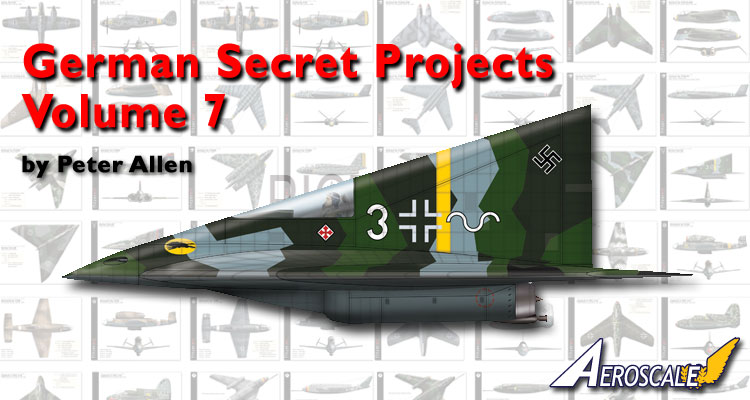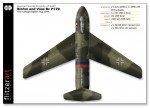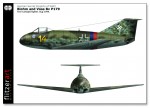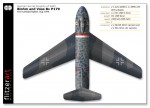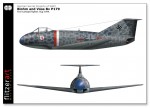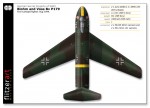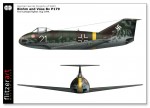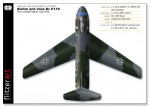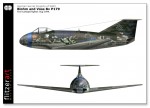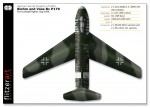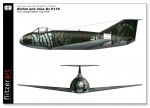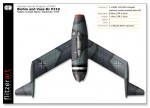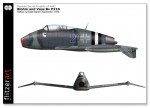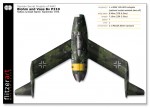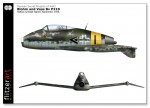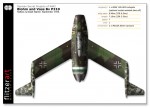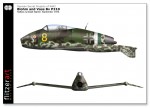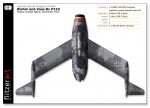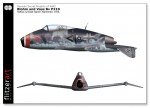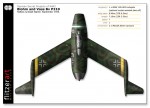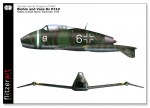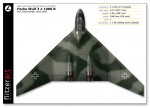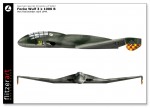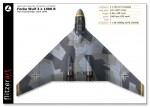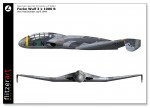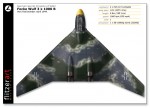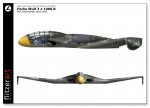German Secret Projects Volume 7
1
Comment
Volume 7 in the current series is the biggest set of profiles I have done to date. It includes 50 subject aircraft making 100 plates in total, again offering a variety of secret project aircraft types, roles and camouflage schemes.
Blohm and Voss BV P197 Twin Jet Engine Fighter
Once the Me 262 had shown its true potential and its programme was well and truly underway, the RLM began looking ahead, contemplating a future successor. Blohm and Voss produced the P197 design in early 1944 and mathematically, at least, proved it would have out-performed the Me 262 in many areas. Due to swept wing knowledge being still new, the P197 would have needed much development in this area.
The novel air intakes also gave question to their effectiveness and would have needed much experiment and development.
The P197 was a very clean, if a little tubby, design laying the two engines side by side within the fuselage being fed by the two intakes low down under the forward fuselage. The concept also featured a T tail. Overall the general look and layout are very familiar with many modern aircraft following similar lines. The RLM remained unconvinced so no further work was carried out on the design.
Blohm and Voss BV P210 Bat-wing Fighter
The RLM issued a requirement for a People’s fighter in 1944 attracting entries from many of the aircraft manufacturers. The eventual selected aircraft was the Heinkel He 162 that was put in to production and saw action late in the war.
Dr Richard Vogt assisted by Dipl-Ing Hans Amtmann after at first hesitating, entered the P210 concept along with two other designs. The P210 study was a development of the P209 and featured the unique Blohm and Voss ‘scissor-wing’ configuration. As was usual with Blohm and Voss the design was simple and promised a cheap method of construction, being made mainly of steel. The principal load-bearing structure was the tubular spar, serving as the intake duct for the engine. All other components and assemblies were attached to this central member.
Even though the P210 design found wide support, the contract was handed to Heinkel, as it was thought the P210 was too uncompromising a design and would therefore need much development work, as promising as it was.
Focke-Wulf 3 x 1000 Fast Bomber
Numerous design studies were done around what is generally known as the 3 x 1000 RLM specification, issued in 1943 after the disappointment of the Heinkel He 177.
The 3 x 1000 was for a fast bomber and was known as such due to it’s requirements of 1000 kph top speed, 1000 Kg bombs payload and 1000 kilometre range.
Focke-Wulf produced three such designs, logically known as the A, B and C. The A and C were for more conventional layouts were as the B featured here was for a tailless delta wing configuration. The concept was largely influenced by Alexander Lippisch ‘s suggestions who worked on Focke-Wulf contracts from time to time. The design included many typical Lippisch features, including the delta wing with downturned wing tips and the cockpit housed in an forward extended module. Also in Lippisch fashion was the compact housing of both the engines side-by-side, the bomb bay and fuel in the centre section. No armament was planned as it was thought the 1000 kph speed sufficient to keep the aircraft out of trouble. Also only light pilot protective armour was planned for the same reason. There was to be only the pilot as crew. Although the design had much merit, no further work was carried out due to the RLM cancelling all bomber projects to concentrate on fighter designs.
Blohm and Voss BV P197 Twin Jet Engine Fighter
Once the Me 262 had shown its true potential and its programme was well and truly underway, the RLM began looking ahead, contemplating a future successor. Blohm and Voss produced the P197 design in early 1944 and mathematically, at least, proved it would have out-performed the Me 262 in many areas. Due to swept wing knowledge being still new, the P197 would have needed much development in this area.
The novel air intakes also gave question to their effectiveness and would have needed much experiment and development.
The P197 was a very clean, if a little tubby, design laying the two engines side by side within the fuselage being fed by the two intakes low down under the forward fuselage. The concept also featured a T tail. Overall the general look and layout are very familiar with many modern aircraft following similar lines. The RLM remained unconvinced so no further work was carried out on the design.
Blohm and Voss BV P210 Bat-wing Fighter
The RLM issued a requirement for a People’s fighter in 1944 attracting entries from many of the aircraft manufacturers. The eventual selected aircraft was the Heinkel He 162 that was put in to production and saw action late in the war.
Dr Richard Vogt assisted by Dipl-Ing Hans Amtmann after at first hesitating, entered the P210 concept along with two other designs. The P210 study was a development of the P209 and featured the unique Blohm and Voss ‘scissor-wing’ configuration. As was usual with Blohm and Voss the design was simple and promised a cheap method of construction, being made mainly of steel. The principal load-bearing structure was the tubular spar, serving as the intake duct for the engine. All other components and assemblies were attached to this central member.
Even though the P210 design found wide support, the contract was handed to Heinkel, as it was thought the P210 was too uncompromising a design and would therefore need much development work, as promising as it was.
Focke-Wulf 3 x 1000 Fast Bomber
Numerous design studies were done around what is generally known as the 3 x 1000 RLM specification, issued in 1943 after the disappointment of the Heinkel He 177.
The 3 x 1000 was for a fast bomber and was known as such due to it’s requirements of 1000 kph top speed, 1000 Kg bombs payload and 1000 kilometre range.
Focke-Wulf produced three such designs, logically known as the A, B and C. The A and C were for more conventional layouts were as the B featured here was for a tailless delta wing configuration. The concept was largely influenced by Alexander Lippisch ‘s suggestions who worked on Focke-Wulf contracts from time to time. The design included many typical Lippisch features, including the delta wing with downturned wing tips and the cockpit housed in an forward extended module. Also in Lippisch fashion was the compact housing of both the engines side-by-side, the bomb bay and fuel in the centre section. No armament was planned as it was thought the 1000 kph speed sufficient to keep the aircraft out of trouble. Also only light pilot protective armour was planned for the same reason. There was to be only the pilot as crew. Although the design had much merit, no further work was carried out due to the RLM cancelling all bomber projects to concentrate on fighter designs.
Comments
Many thanks Rowan
for doing a great job again in getting it up and running.
Cheers
Peter
NOV 26, 2010 - 10:59 PM
Copyright ©2021 by Peter Allen. Images also by copyright holder unless otherwise noted. The views and opinions expressed herein are solely the views and opinions of the authors and/or contributors to this Web site and do not necessarily represent the views and/or opinions of AeroScale, KitMaker Network, or Silver Star Enterrpises. Images also by copyright holder unless otherwise noted. Opinions expressed are those of the author(s) and not necessarily those of AeroScale. All rights reserved. Originally published on: 2010-11-22 00:00:00. Unique Reads: 19065




